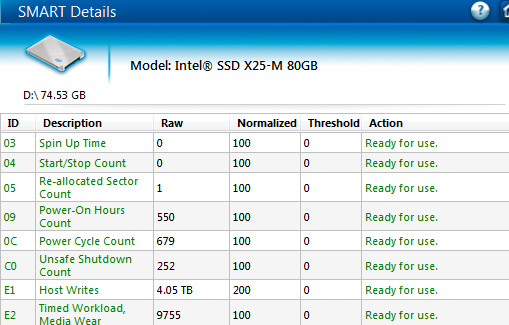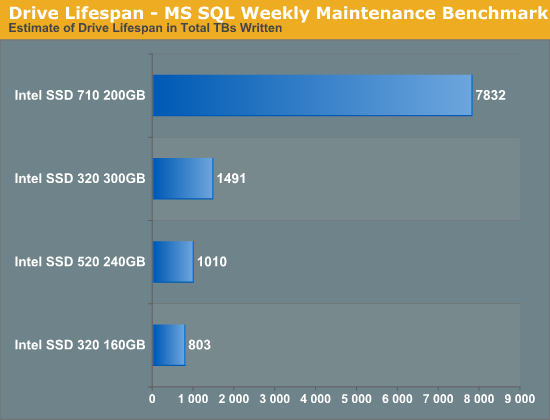A Look at Enterprise Performance of Intel SSDs
by Anand Lal Shimpi on February 8, 2012 6:36 PM EST- Posted in
- Storage
- IT Computing
- SSDs
- Intel
Measuring How Long Your Intel SSD Will Last
Earlier in this review I talked about Intel's SMART attributes that allow you to accurately measure write amplification for a given workload. If you fire up Intel's SSD Toolbox or any tool that allows you to monitor SMART attributes you'll notice a few fields of interest. I mentioned these back in our 710 review, but the most important for our investigations here are E2 (226) and E4 (228):

The raw value of attribute E2, when divided by 1024, gives you an accurate report of the amount of wear on your NAND since the last timer reset. In this case we're looking at an Intel X25-M G2 (the earliest drive to support E2 reporting) whose E2 value is at 9755. Dividing that by 1024 gives us 9.526% (the field is only accurate to three decimal points).
I mentioned that this data is only accurate since the last timer reset, that's where the value stored in E4 comes into play. By executing a SMART EXECUTE OFFLINE IMMEDIATE subcommand 40h to the drive you'll reset the timer in E4 and the data stored in E2 and E3. The data in E2/E3 will then reflect the wear incurred since you reset the timer, giving you a great way of measuring write amplification for a specific workload.

How do you reset the E4 timer? I've always used smartmontools to do it. Download the appropriate binary from sourceforge and execute the following command:
smartctl -t vendor,0x40 /dev/hdX where X is the drive whose counter you're trying to reset (e.g. hda, hdb, hdc, etc...).
Doing so will reset the E4 counter to 65535. The counter then begins at 0 and will count up in minutes. After the first 60 minutes you'll get valid data in E2/E3. While E2 gives you an indication of how much wear your workload puts on the NAND, E3 gives you the percentage of IO operations that are reads since you reset E4. E3 is particularly useful for determining how write heavy your workload is at a quick glance. Remember, it's the process of programing/erasing a NAND cell that is most destructive - read heavy workloads are generally fine on consumer grade drives.

I reset the workload timer (E4) on all of the Intel SSDs that supported it and ran a loop of our MS SQL Weekly Maintenance benchmark that resulted in 320GB of writes to the drive. I then measured wear on the NAND (E2) and used that to calculate how many TBs we could write to these drives, using this workload, before we'd theoretically wear out their NAND. The results are below:

There are a few interesting takeaways from this data. For starters, Intel's SSD 710 uses high endurance MLC (aka eMLC, MLC-HET) which is good for a significant increase in p/e cycles. With tens of thousands of p/e cycles per NAND cell, the Intel SSD 710 offers nearly an order of magnitude better endurance than the Intel SSD 320. Part of this endurance advantage is delivered through an incredible amount of spare area. Remember that although the 710 featured here is a 200GB drive it actually has 320GB of NAND on board. If you set aside a similar amount of spare area on the 320 you'd get a measurable increase in endurance. We actually see an example of that if you look at the gains the 300GB SSD 320 offers over the 160GB drive. Both drives are subjected to the same sized workload (just under 60GB), but the 300GB drive has much more unused area to use for block recycling. The result is an 85% increase in estimated drive lifespan for an 87.5% increase in drive capacity.
What does this tell us for how long these drives would last? If all they were doing was running this workload once a week, even the 160GB SSD 320 would be just fine. In reality our SQL server does far more than this but even then we'd likely be ok with a consumer drive. Note that the 800TBs of writes for the 160GB 320 is well above the 15TB Intel rates the drive for. The difference here is that Intel is calculating lifespan based on 4KB random writes with a very high write amplification. If we work backwards from these numbers for the MLC drives you'll end up with around 4000 - 5000 p/e cycles. In reality, even 25nm Intel NAND lasts longer than what it's rated for so what you're seeing is that this workload has a very low write amplification on these drives thanks to its access pattern and small size relative to the capacity of these drives.
Every workload is going to be different but what may have been a brutal consumer of IOs in the past may still be right at home on consumer SSDs in your server.










55 Comments
View All Comments
Anand Lal Shimpi - Wednesday, February 8, 2012 - link
There's a *ton* of data that we manage. We run statistics, ad serving and forums all in house. Among other things, we can guarantee that no one funny is looking at the data we manage.Statistics are pretty beefy (they are one of our enterprise workloads after all) as we're tracking requests to all articles published. Couple a few hundred thousand readers per day with multiple article requests per reader and that's a lot of traffic to keep track of. Multiply all of that by a few ads per page and you can see where ad serving/tracking gets insane.
Then there are the forums. Repeat the same workload as above but across a different, but also quite large community.
The MS SQL server is main site, the My SQL server is forums + ads :)
Take care,
Anand
Lord 666 - Wednesday, February 8, 2012 - link
@Anand,What model server and what controller was it using with the qty 8 320 drives? Been waiting for an article like for this for some time.
Anand Lal Shimpi - Thursday, February 9, 2012 - link
The temporary hardware is a Dell R710 I believe. We're simply using Intel's Matrix RAID, no real need for a discrete PCIe RAID solution for what we're doing. I'll be providing more details about our final hardware configuration and how it compares to what we were running on for the past few years in the not too distant future.Take care,
Anand
mojobary - Thursday, February 9, 2012 - link
Hi,This is exactly the information I am interested in. I am a video editor, so my needs are typically long sequential reads. I would be interested in RAID adapters, iSCSI and Fibre channel RAID enclosures in respect to using SSDs. This is something that not much good information is present out in the wild. I have been researching this topic for about nine months and do not have conclusive information. Even from vendors which say "they support ssd", they don't list supported drives or even TRIM support. I typically like this site as it seems unbiased in the regard and usually helps me drive purchasing decisions.
bobbozzo - Monday, February 13, 2012 - link
HDDs are pretty good at sequential reads (and writes).For the same $, you'd be able to get more HDDs, and therefore higher sequential performance, than SSDs.
This will remain true until SSDs get MUCH faster sequential performance, or get MUCH cheaper than they currently are.
Movieman420 - Wednesday, February 8, 2012 - link
Given the 710's obvious benefit of using HET nand it'd be nice to see a comparison between it and an eMLC equipped Ocz SF2500 Deneva 2 drive. :evil grin:Anand Lal Shimpi - Thursday, February 9, 2012 - link
I'm trying to get more enterprise SSDs in house. I've got a bunch that I'm working on now actually. Not the Deneva 2 sadly :)Take care,
Anand
Sufo - Thursday, February 9, 2012 - link
How about the HP for ProLiant drives? Also, anything from Anobit?Is the 710 a realistic option for enterprise?
zepi - Wednesday, February 8, 2012 - link
I was hoping on some input regarding TRIM and SSD RAIDs in enterprise environments. What if I stick these babies to a proper raid-controller to run them in RAID 5? Or how about under other operating systems than Windows? Do the drives choke quickly if trim is not available or is it a non-issue? Does trim work in a software RAID array, assuming my operating system supports it? And how about trim / garbage collection behavior if the drives are never idle?Afaik Intel has released RAID 0- and RAID 1-compatible drivers that support trim, but only for Windows. Was that active in your test or does it even matter the slightest?
lonestar212 - Wednesday, February 8, 2012 - link
I was about ask exactly the same thing. Very curious about this!